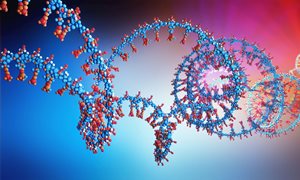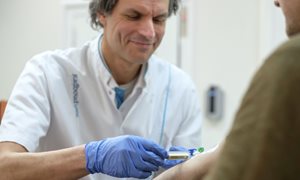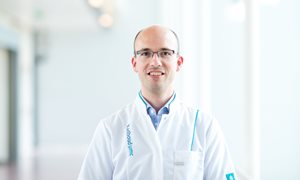
Being able to automatically recognize lung tumors on CT scans: professor of functional image analysis Bram van Ginneken developed software within his Vici project that is now used worldwide. The resulting cost savings bring the introduction of a population-based lung cancer screening closer.
What motivated your Vici research?
'In 2011, U.S. researchers showed with a large randomized trial that the use of CT scans in a population-based study can reduce lung cancer mortality. Lung cancer is the deadliest cancer because it is often detected too late. In my research group, we had been working on automatically detecting abnormalities on CT scans since 2004. The Vici award was the ideal opportunity to bring both developments together.'
What was the most important question within the project?
'A thoracic CT scan is a three-dimensional image of the upper body made up of two-dimensional sections. The radiologist has to scroll through such a scan slice by slice and see if he sees anything strange. That takes a lot of time. We wanted to automate that assessment. The ultimate goal was for the computer to be able to fill in all the boxes on the radiologist's assessment form. So we wanted to be able to not only draw a circle around a suspicious spot but also automatically indicate whether the patient can just wait for another screening call, or whether he needs to see a doctor sooner.'
What did you research?
'We developed and trained algorithms with tens of thousands of examples of CT scans. On those, doctors had indicated which abnormalities might indicate lung cancer. Then we had our system review new CT scans, and physicians checked those reviews and improved or added to them where necessary. In the end, we arrived at a system that can assess scans at the population level just as well as doctors can. In individual cases, however, things can still go wrong: rare cases that the algorithm has never seen before it cannot recognize. It is therefore crucial that we continue to train such an artificial intelligence-based system with new data.'
What has the project achieved so far?
'My Vici project has led to software that is now used worldwide, sold by Mevis Medical Solutions. Because it is not yet socially accepted that computers can draw medical conclusions on their own, the software is now mainly used to support radiologists. The computer analyzes the CT scan and indicates which spots the radiologist should definitely look at. In this way, a radiologist can complete his work twice as quickly. In addition, the computer can immediately see other abnormalities on a chest CT. In this way we can also recognize and quantify arteriosclerosis and COPD with great accuracy. Both conditions are common among smokers, the first group that would qualify for lung cancer screening. In fact, more smokers die of cardiovascular disease from arteriosclerosis than from lung cancer. So you could make health gains in that way too. A long-term study is currently under way in Groningen into whether it makes sense to add these screenings.'
For whom is this research especially useful?
'For society as a whole. In the first place, it's great for patients if you can detect the cancer at a time when something can still be done about it. At the same time, our software helps to contain healthcare costs. In discussions about population screening there is always a cost-benefit analysis: do the costs outweigh the expected health benefits? As long as radiologists have to manually assess all those CT scans, introducing lung cancer screening is very expensive.Our research leads to cost savings and thus lowers the threshold for the introduction of this population study.'
Do you have any tips for fellow researchers pursuing knowledge utilization from basic research?
'Commit to strategic, long-term collaborations with partners who share your vision. I want to develop things that have an impact on healthcare. But I can't do that alone. I have to work with companies to do that. In this case, Mevis has negotiated an exclusive right to use the software. In the context of open science, you can of course have reservations about that. However, I think it is fine, since the consequence is that our results are now actually being used. And we can use the royalties to pay new researchers in our group.'
What is still needed from others to take this further?
'Artificial intelligence (AI) is emerging in healthcare: there are now some 150 CE certified AI products for radiology. But there needs to be a system in place to ensure that that software is also continuously improved. Hospitals now almost never share their data, for privacy reasons or cold feet. But if you really want to develop safe artificial intelligence, data sharing, especially of scans with the more rare abnormalities, is a necessity. The software must be able to learn from its mistakes. If there is a fatal accident somewhere, we investigate how to prevent a recurrence. The same must happen if a computer makes an error in judgment, especially in a medical setting.'
More information
- Research group Bram van Ginneken
- Software that the project has produced
- Interview in the Volkskrant
- A call from patients, physicians and researchers to include in the Coalition Agreement that the Netherlands start a population-based lung cancer screening.
Source NWO
-
Want to know more about these subjects? Click on the buttons below for more news.
Related news items

New start-up Patholyt will bring AI research into pathology diagnostics
21 September 2021 Patholyt is on a mission to accelerate the adoption of artificial intelligence in pathology diagnostics and improve the chances of cancer patients worldwide. Patholyt is a spin-off from Radboudumc, a frontrunner in computational pathology research. go to page
A single comprehensive DNA test of a tumor is usually sufficient
25 August 2021 A one-time measurement of the entire tumor DNA is almost always sufficient to find all DNA errors that are important for treatment. go to page



